April 01, 2021
Admin
5 min.
Lifestyle
Recipe for Medu Vada Recipe of Medu Vada Medu Vada Recipe
Disclosure : When you purchase a service or a product through our links, we sometimes earn a commission, at no extra cost to you.
Recipe for Medu Vada - How to Make Medu Vada
Recipe of Medu Vada is a popular South Indian breakfast recipe. That being said, what is Medu Vada, would be the first question that may come in the mind of a person who has not much exposure to South Indian dishes. Medu Vada is a South Indian dish, with some resemblance to Pakora, which is made in North India. However, one notable difference is that Medu Vada is made up of Urad Dal whereas Pakora is made from Besan (Gram Flour).
In different states of South India, it is known by different names. In Andhra Pradesh, it is known as Garelu. In Kerala, it is popularly called as Uzhunnu vada. In Tamil Nadu, it is known as Medu Vada. Though the dish may have a different name in different places, finally the dish is the same and has a unique taste. Though Medu Vada is generally taken in Breakfast, it can be also taken as a snack.
Medu Vada has a quite lovable taste, for which this dish is also prepared at home, by both South Indians & those who live in other parts of the country. Though the main ingredient of Medu Vada Recipe is Urad Dal (Split Dehusked black gram lentils), some people also choose to prepare the dish by using Chana Dal (Brown Split Chick Peas) along with Urad Dal.
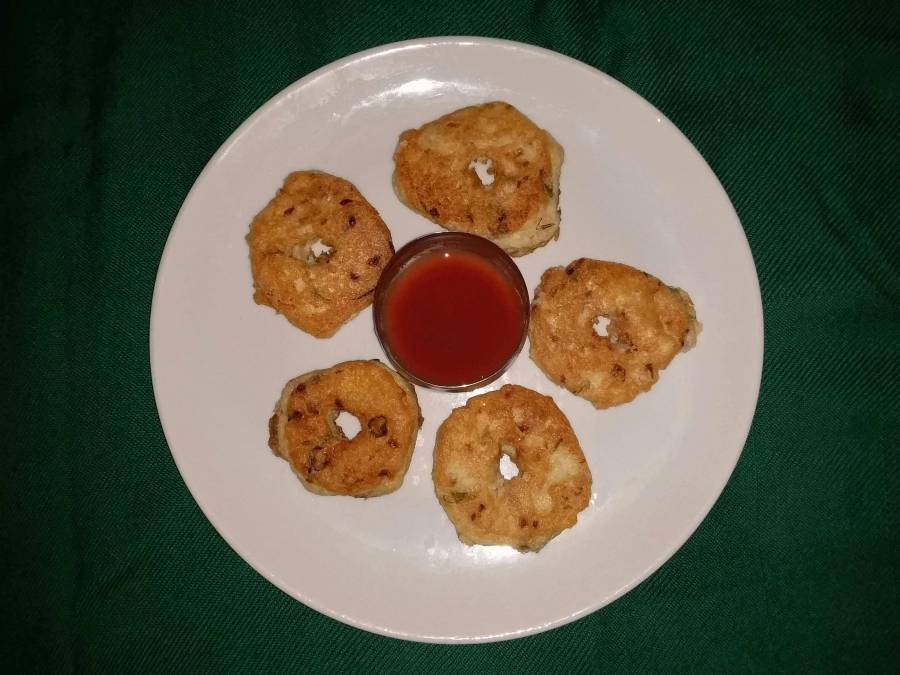
The Recipe of Medu Vada can be easily prepared at home.
Few people also choose to add Semolina to the preparation. However, these are optional personal choices, and not part of the method of preparation used by the majority. So, it must be obvious by now that how to prepare Medu Vada, is a question that may have some minor variations in its answers.
Here, for the benefit of all those who want to know as to how to make Medu Vada at home, we will discuss the simple type of Recipe of Medu Vada, that is classically prepared in South Indian homes & restaurants. We have also described the finer points of how to make Medu Vada soft and crispy so that the final product tastes quite appealing.
Medu Vada Recipe
Ingredients Used in Recipe for Medu Vada
1) Urad Dal (Split & Dehusked Black Gram Lentils) – 1 cup
2) Onion – 1 of medium size (very finely chopped)
3) Green Chilli – 1 in number (finely chopped)
4) Salt – 1/4th teaspoon
5) Hing (Asafoetida) – A big pinch
6) Black Pepper (optional – not used here) – 8 to 9 in number (roughly crushed)
7) Ginger – 1½ inch long (coarsely grated)
8) Cumin seeds – ½ teaspoon
9) Baking Soda – 1/4th teaspoon
10) White Oil (for frying) – 1 cup
11) Coriander Leaves – 10 grams (very finely chopped)
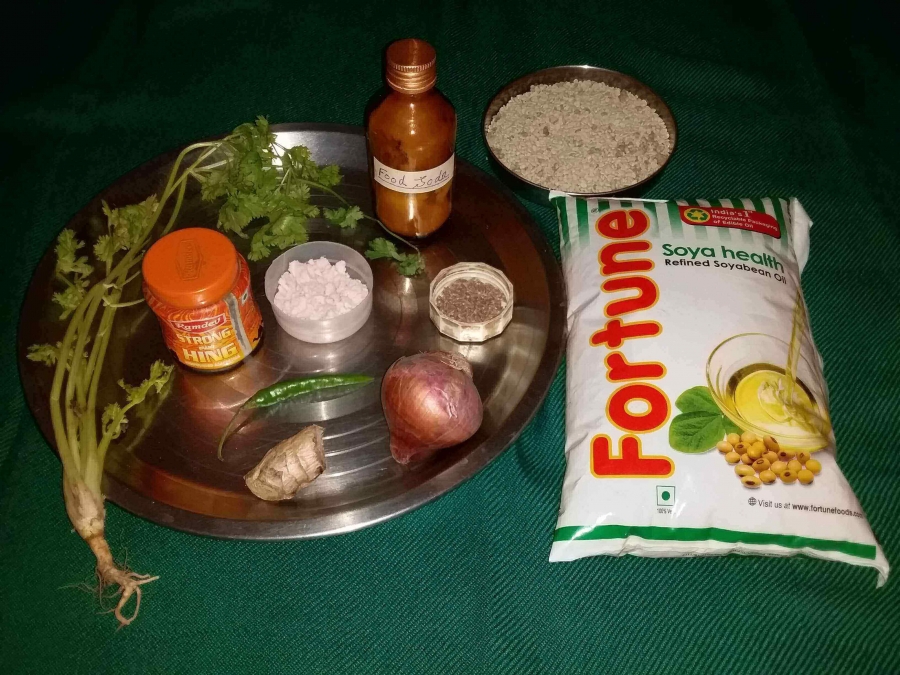
Ingredients used in Recipe for Medu Vada.
How to Make Medu Vada
-
Soak Urad dal in a deep vessel bowl containing normal water. The water level should be at least 2-inch-high from the Urad Dal level. Keep the dal soaked in water for at least 3 hours, but not for more than 4 hours – which can later make the final preparation very hard.
-
After 3 hours, drain out the water from the dal and transfer the dal into a mixer- grinder or an old fashioned traditional Indian wet grinder. Here we have used a modern mixer-grinder, which runs on electricity. Later, add 1 tablespoon ice-cold water to the contents and grind the dal. This ensures that the final preparation becomes softer.
-
After 1 to 2 minutes, stop the mixer – grinder and add 1 tablespoon ice-cold water to the contents. Next the mixer- grinder is again run for grinding the dal into a paste form. However, always keep this in mind, the ground dal should be hard enough so that later it could be molded into the correct shape of Medu Vada. So, do not add too much ice-cold water at the time of grinding.
-
Once the dal is ground and attains a smooth paste-like texture then take out the dal from the grinder -mixer and keep it in a deep vessel bowl.
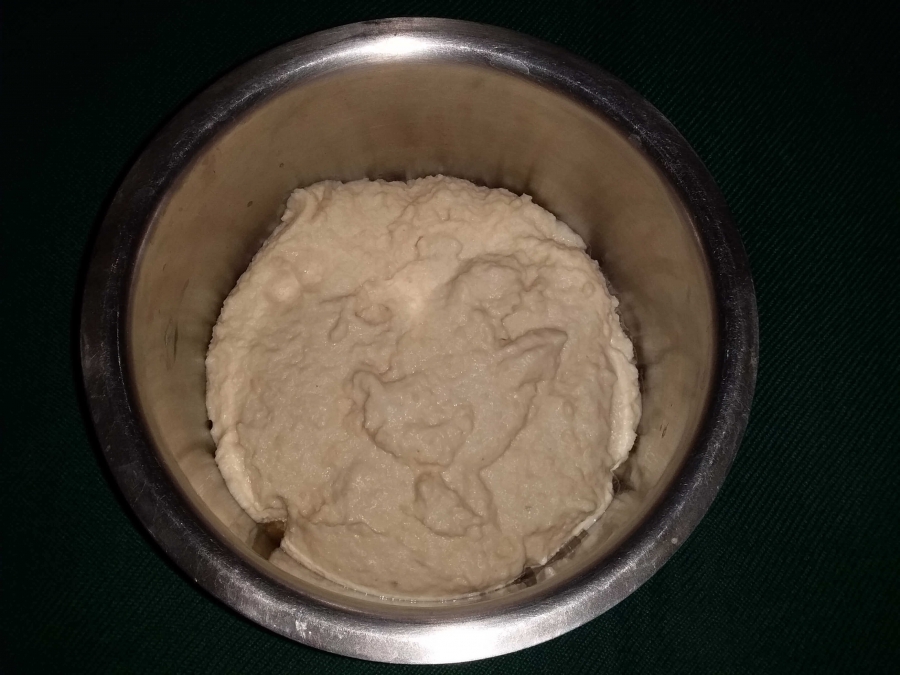
Thick ground paste of Dal used in Recipe of Medu Vada.
-
Beat the dal properly in one direction (either in clockwise or in an anticlockwise direction) till it becomes fluffy.
-
Then take a glass full of normal water and drop into it, a tiny ball of Urad Dal from the main paste. If this ball floats on the upper surface of the water, that means the paste preparation is ready for the next step of cooking. If not then it means, the paste should be beaten a little longer, till it fulfills this criterion.
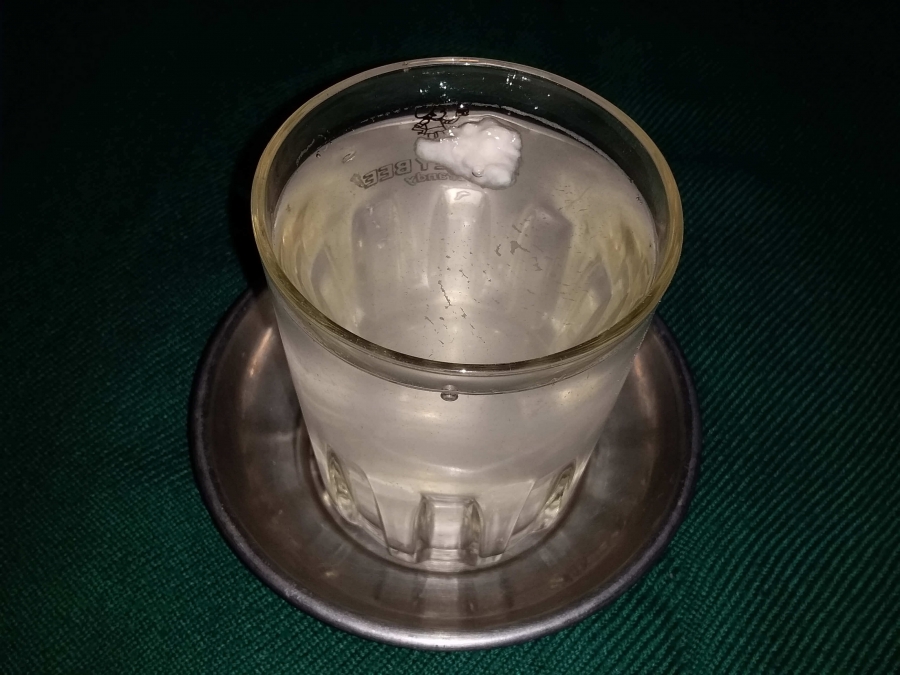
Dal paste floating on water as described in Medu Vada Recipe.
-
In the next step, mix all the ingredients described in the ingredient chart to the dal paste. Mix all the components uniformly by beating the dal mixture once more, in the same direction, as before.
-
Now put a non-stick pan/Karahi on a low medium flame burner. Add 1 cup white edible oil in it and allow it to get warm. How to make the shape of Medu Vada, is a question that is quite often asked by inexperienced chefs, who are preparing this dish for the first time. The next paragraph is going to explain this easily.
-
When the oil in the pan gets warm then take 1 ½ tablespoon of the dal mixture paste on a plastic paper/silver foil. Give a little pressure from above and make a thick flat spherical shaped mass. Make a hole in its center, by inserting a thumb finger in the center of it.
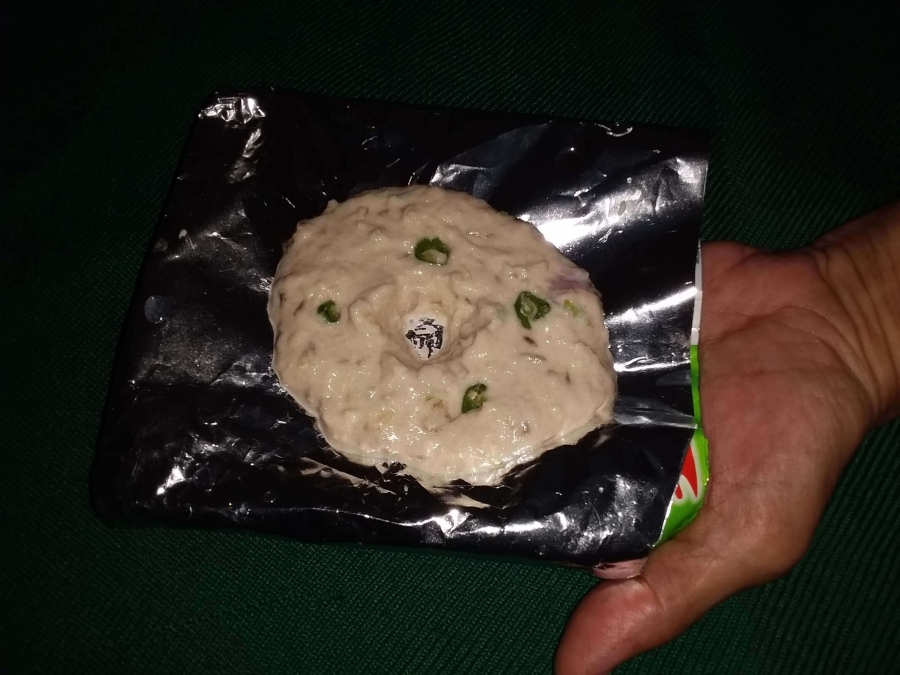
Making raw Vada, with hole in center, over a silver foil as described in Medu Vada Recipe.
-
Later drop this carefully in the hot oil. For an experienced chef, this process can be done by simply using the palm also, but for beginners, the use of silver foil or the plastic paper is safer. The Vada should be fried carefully from both sides, by the help of a ladle.
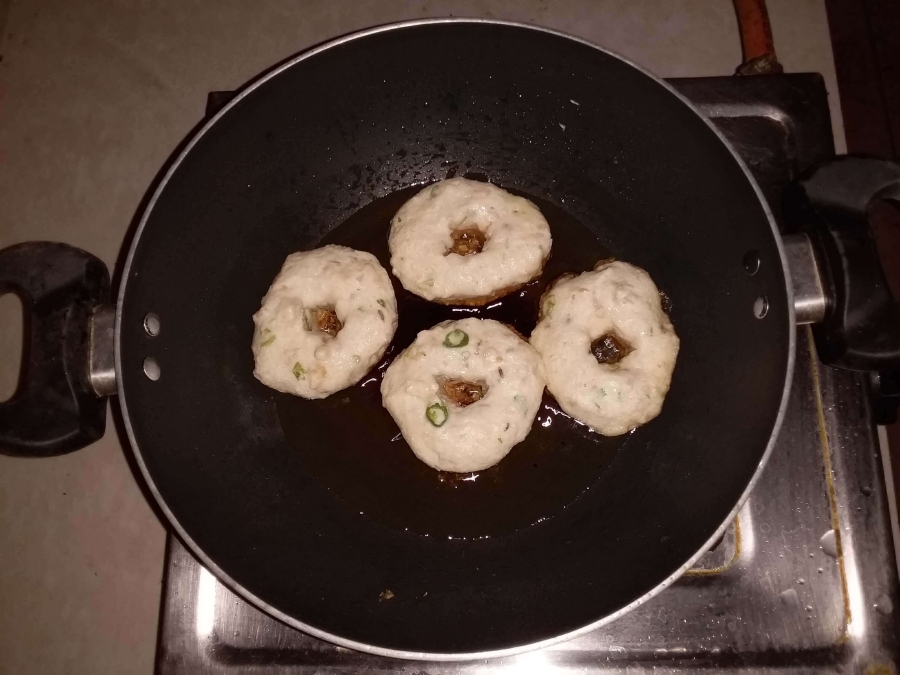
Medu Vada being prepared by using Recipe for Medu Vada.
-
Once the Vada becomes golden brown (and gets fried properly) then take it out from the oil and keep it on a plate, covered by tissue paper to soak the oil. Like this way fry all the previously prepared Urad dal mixture in the shape of Vada.
-
Medu Vadas are ready now for serving to your friends and family. Medu Vada can be served along with Coconut Chutney, Peanut Chutney, or Red Tomato chutney or Sambar.
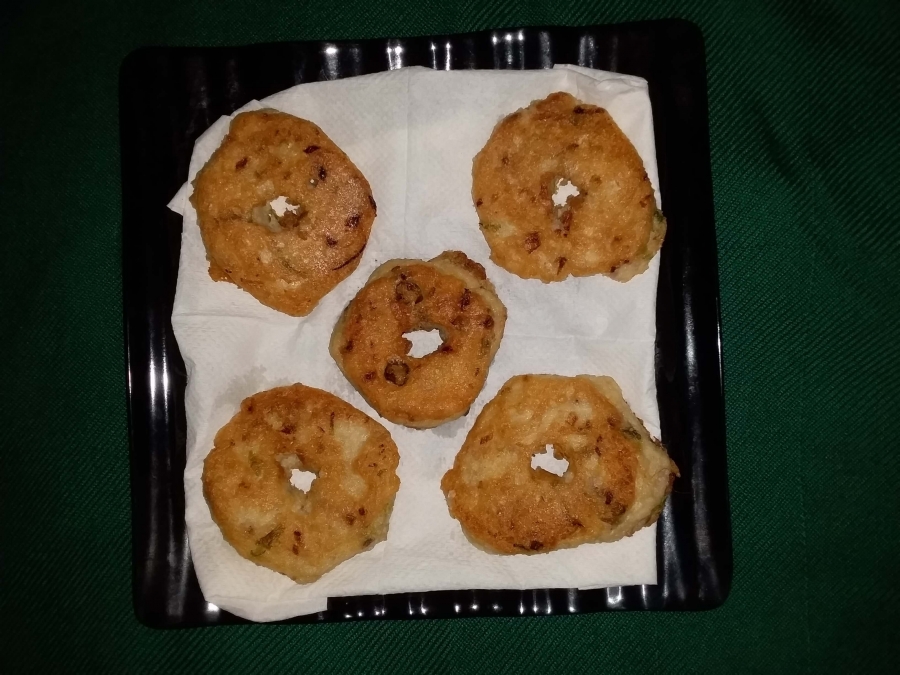
Medu Vada - Final preparation made by using Recipe of Medu Vada.
Some Useful Tips to be Used in Recipe for Medu Vada
-
How to make Medu Vada crispy, is a question that is often asked. To achieve this goal the following precaution should be taken. While beating the dal, it should be always beaten in one direction only, so that the air will mix with the dal paste/mixture properly and the mixture will become fluffy, which would make the Vada soft, crispy and spongy.
-
Do not add too much water to the dal at the time of grinding. If the mixture becomes thin then it will be difficult for frying Vada.
-
Mix the salt to the dal mixture just before frying the Vada otherwise the mixture will be thin in texture and would get fried very fast and it will be difficult to fry the Vada properly in the correct shape. After putting salt in the mixture, the mixture would slowly get thinned, so the mixing of salt to the preparation should be done just before frying.
-
At the time of frying Vadas, the flame should be of low medium otherwise the outer portion of the Vada will get fried very fast and the inner portion will remain raw and uncooked.
-
In the time of grinding dal, little ice-cold water should be added to it, otherwise, if it becomes hot then the final Vada preparation would become hard after frying.
-
Do not soak the dal for more than 4 hours in the water, otherwise, the final Vada preparation will become hard and soggy.
-
In case the dal mixture accidentally becomes thin in consistency, then mix a small quantity of Semolina (Suji) to the preparation according to need and prepare the Vada as has been described earlier.
(DECLARATION - All the images used in this site, are either from personal collection, or are images available in Public Domain. The owner of this website is grateful to all those, who donated their images to – Wikipedia, Wikimedia, Flickr, Pixabay, Picryl and all other sites; for free use, as images in Public Domain.)
Disclosure: When you purchase a service or a product through our links, we sometimes earn a commission, at no extra cost to you.





